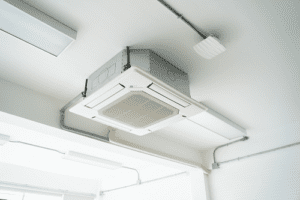For smaller homes or businesses, or even for units in an apartment building or condo, it might not always make sense to have a traditional ducted HVAC system. While central heat and air are the best options for most houses or larger buildings, they can be too costly—and too space-intensive—for smaller spaces. Property owners seeking effective heating and cooling means for these types of situations might find what they need in the form of a heat and air split unit. These units consist of an outdoor piece and an indoor, wall-mounted unit—hence their status as “split” system. Since there are no ducts, split systems are by far the most effective for heating or cooling a single room. However, in smaller living or business spaces, they can provide considerable benefits. We’ve listed the four biggest advantages of a mini-split system below.
- No need for ductwork
 The biggest advantage of a heat and air split unit is also its most definitive quality, which is that it doesn’t require any ductwork. Central HVAC systems are expensive to purchase and install in part because they are so large and in part because so much installation and preparation work are required. In fact, these factors make it very difficult to install a central HVAC setup retroactively. Tearing up a home to add ductwork—or even finding space for all the ducts to go—isn’t realistic or cost-effective in many situations. Thus, older homes in need of new heating or cooling systems are good candidates for mini-split systems. These units are much smaller and much less expensive to install than a ducted system.
The biggest advantage of a heat and air split unit is also its most definitive quality, which is that it doesn’t require any ductwork. Central HVAC systems are expensive to purchase and install in part because they are so large and in part because so much installation and preparation work are required. In fact, these factors make it very difficult to install a central HVAC setup retroactively. Tearing up a home to add ductwork—or even finding space for all the ducts to go—isn’t realistic or cost-effective in many situations. Thus, older homes in need of new heating or cooling systems are good candidates for mini-split systems. These units are much smaller and much less expensive to install than a ducted system.
- Zoned control
One of the big benefits of split systems—and one of the reasons they are often the go-to option for landlords managing apartment buildings or rental units—is that they allow for easy and affordable zone temperature control. Zoning, of course, can be incorporated into a ducted system, but often at additional cost and installation work. With a split system—or a series of split systems in different rooms/parts of a house—each unit is its own standalone entity. Thus, it’s simple to set the temperature on the split system a little bit differently for each room. In apartment buildings where each tenant has different preferences for temperature and comfort, it can be beneficial to have this level of zoned control.
- They offer efficiency benefits
Ductwork is necessary for large spaces to deliver heated or cooled air from a central unit throughout the home or building. Unfortunately, though, this kind of setup doesn’t come without its drawbacks. For one thing, central HVAC systems must exert energy to propel air on a relatively long journey. For another, the duct setup can prevent some of the conditioned air from making it all the way from the central unit to the rooms it is intended to heat or cool.
For instance, if there are cracks or leaks in the ducts, they will be losing air and the energy that was necessary to heat or cool it. Dirty ductwork can impede airflow and push the HVAC system to work that much harder to achieve the desired temperature. Ducts running through exposed or unconditioned spaces—such as attics or some garages—can suffer a heat transfer problem that impacts their ability to deliver properly conditioned air to the final destination. All told, due to these shortcomings and others, the United States Department of Energy estimates that “duct losses can account for more than 30% of energy consumption for space conditioning.”
Split systems don’t face these problems, in part because they are pushing freshly conditioned air directly into the room.
- No need for duct cleaning
Another drawback of ducts for an HVAC system is that they can become a collecting point for all sorts of debris and contaminants, ranging from dust and pet hair to mold and mildew. Professional HVAC contractors are experienced in cleaning ductwork to eliminate these issues. However, the fact is that many homeowners and business owners are unaware of the risks of leaving their ducts uncleaned, which include air quality issues and resulting health concerns.
Eliminating ducts from the HVAC equation also removes the need for regular duct cleaning. However, do note that split systems will still need to be cleaned and maintained regularly. Your HVAC contractor will be able to advise you on how precisely to clean your specific system, but regular dusting of the interior unit, replacement of filters, and cleaning of the evaporator coils are all recommended.
Deciding Whether a Heat and Air Split System Is Right for You
As you can see, heat and air split systems certainly have a lot going for them when it comes to HVAC installations. They aren’t right for every home or business, but they may be right for you. Contact a trusted HVAC contractor today for help weighing the pros and cons.

